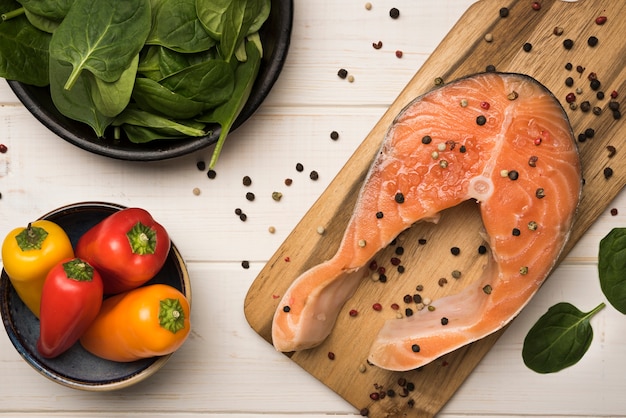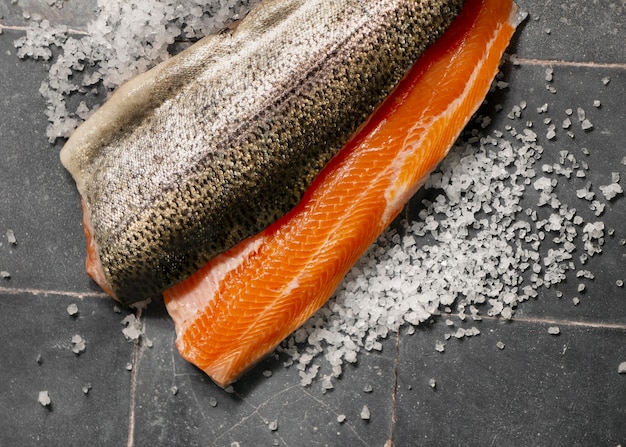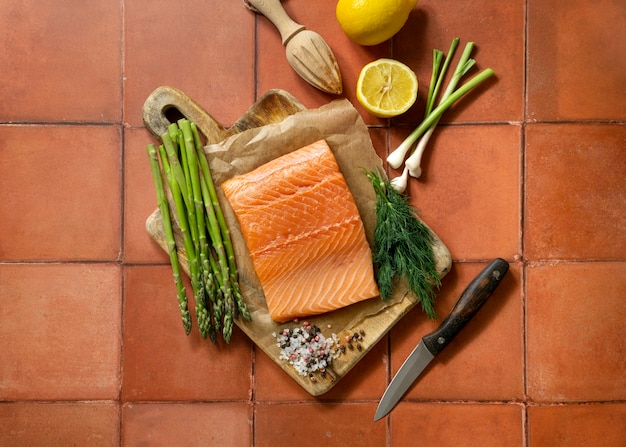As a seasoned cook with a deep-seated love for salmon, I've spent countless hours in the kitchen, experimenting with different techniques and recipes. One question that's always lingered in my mind is: Should you cook salmon skin side down? It seems like a simple question, but the answer, as you'll soon discover, is far from straightforward. Join me on a culinary journey as we explore the pros and cons of this age-old debate, delve into the science behind it, and ultimately, determine the best approach for you. Along the way, we'll uncover some surprising insights and tips that will elevate your salmon game to new heights.
Part 1: The Great Skin Side Down Debate

The salmon skin side down vs. skin side up debate has been raging in kitchens for ages. It's a bit like the "Coke vs. Pepsi" of the culinary world, with passionate advocates on both sides. As a food enthusiast who always seeks to understand the "why" behind every culinary technique, I've always been curious about the science and rationale behind these opposing viewpoints. Let's dive into the arguments for each side and see if we can find some clarity in this sea of culinary controversy.
Why You Might Cook Skin Side Down:
Proponents of cooking salmon skin side down often cite the following reasons, each with its own compelling logic:
- Crispier Skin: When the skin is placed down, it receives direct heat from the pan or oven rack. This creates a crispy, golden brown texture that's simply irresistible. Imagine the satisfying crunch as you bite into your perfectly cooked salmon, a true delight for the senses. This crispy skin is a culinary masterpiece, adding a delightful textural contrast to the tender fish.
- Juicier Fish: Some believe that cooking skin side down prevents the delicate flesh from drying out, resulting in a moister, more flavorful salmon. The skin acts like a protective layer, trapping the juices and ensuring a tender, succulent bite. It's like a natural barrier, keeping the fish moist and delicious.
- Easier to Flip: When the skin is down, it's easier to flip the salmon without breaking it apart. The skin acts as a protective barrier, allowing for a smooth and seamless flipping experience. This is especially helpful for beginners, as it minimizes the risk of ending up with a broken fillet. It's a culinary hack that can save your dish from disaster.
Why You Might Cook Skin Side Up:
Now, let's hear from the other side. Those who advocate for skin side up cooking argue that:
- Even Cooking: Some contend that the skin side up method helps ensure even cooking, as the heat can penetrate the fish more evenly from the top. This is particularly important for thicker fillets, where it can be tricky to achieve perfect doneness throughout. It's all about getting that perfect, evenly cooked fish, from the outside in.
- More Moisture Retention: Others believe that the skin acts as a natural barrier, protecting the fish from excessive heat and preventing it from drying out. This method is especially popular for delicate fish like salmon, as it helps retain its natural moisture and tenderness. It's like wrapping the fish in a protective blanket, ensuring it stays moist and flavorful.
- Easier to Remove Skin: Some chefs find it easier to remove the skin after cooking if the salmon is cooked skin side up. This is especially true when grilling or pan-searing, where the skin tends to become quite crispy. It's a matter of preference, of course, but some find the skin easier to remove when it's facing up. It's a subtle difference, but one that can make a difference for some cooks.
Part 2: The Science Behind the Skin

Let's dig a little deeper and look at the science behind this culinary conundrum. What exactly is happening to the skin when we cook it? Understanding the science can help us make informed decisions about our cooking techniques. It's not just about following recipes; it's about understanding the why behind the how.
The Collagen Connection
Salmon skin is primarily composed of collagen, a protein that breaks down and becomes gelatinous when exposed to heat. This process is what gives the skin its characteristic texture. When cooked skin side down, the heat directly penetrates the skin, causing the collagen to melt and create a crispy, gelatinous layer. It's essentially a delicious, edible form of glue, holding the fish together and trapping its juices. This process is what creates the irresistible crispy skin and the juicy, flavorful fish. It's a fascinating transformation that happens right before our eyes.
The Moisture Myth
While some argue that cooking skin side down prevents moisture loss, the truth is a bit more nuanced. The skin doesn't actually trap moisture; it simply prevents the surface from drying out too quickly. However, the gelatinous layer that forms can make the fish appear moister, as the juices are essentially trapped within the skin. It's a bit like a delicious, edible glaze, adding a layer of richness and flavor to the salmon. It's a delicate balance of science and artistry that creates a truly delectable dish.
Part 3: My Personal Experience

Having experimented with both methods countless times, I've reached my own conclusion about the best way to cook salmon. As a lover of crispy skin and juicy flesh, I prefer cooking salmon skin side down. It allows for the skin to become perfectly crisp while ensuring the fish is cooked evenly and remains juicy. It's a culinary technique that I've come to trust and enjoy, consistently delivering delicious results. However, it's important to note that there is no one-size-fits-all answer. The ideal method will ultimately depend on your personal preferences, the thickness of the fillet, and the cooking method you choose. It's all about finding what works best for you and your kitchen.
Part 4: Tips for Cooking Skin Side Down
If you're eager to try cooking salmon skin side down, here are some tips to help you achieve perfect results. These tips will help you navigate the process, ensuring a smooth and successful culinary experience. It's all about attention to detail and a little bit of culinary know-how.
Choose the Right Pan:
A cast iron pan is ideal for this method, as it provides even heat distribution and helps create a beautifully crisp skin. The cast iron's heat retention is key, ensuring the skin cooks evenly and achieves that perfect crispy texture. However, a non-stick pan will also work well if you prefer easier cleanup. Remember to preheat the pan thoroughly before adding the salmon. This preheating step is crucial for achieving that perfect sear. It's all about setting the stage for a culinary masterpiece.
Pat the Salmon Dry:
Before cooking, pat the salmon dry with paper towels to remove any excess moisture. This will help the skin crisp up nicely and prevent steaming, which can result in a soggy texture. It's a simple step that makes a big difference in the final result. It's all about creating the optimal conditions for a crispy, delightful skin. It's a small step with a big impact.
Don't Overcrowd the Pan:
Give each piece of salmon ample space in the pan. Overcrowding will prevent the skin from crisping up and can lead to uneven cooking. It's all about giving each fillet its own space to shine, ensuring that each piece cooks evenly and to perfection. If you're cooking multiple fillets, cook them in batches to ensure optimal results. It's a matter of patience and planning, but it will be worth it in the end.
Use Low to Medium Heat:
Cook the salmon over low to medium heat. High heat can easily burn the skin before the fish is cooked through. A gentle approach is key to achieving a perfectly crispy skin without sacrificing the delicate flesh of the fish. It's all about finding that sweet spot, where the skin crisps up beautifully and the fish cooks evenly. It's a delicate balance that requires a bit of culinary finesse.
Flip It Once:
Once the skin has developed a nice golden brown color, flip the salmon over and cook for another minute or two, just until the fish is cooked through. Resist the urge to flip it back and forth, as this can interrupt the cooking process and make the fish dry out. It's a matter of patience and timing. Trust the process and let the salmon do its thing. It will reward you with a perfectly cooked fish.
Rest Before Serving:
Allow the salmon to rest for a few minutes before serving. This will help the juices redistribute, ensuring a more tender and flavorful fish. The wait is worth it, as it will enhance the overall dining experience. Let the salmon rest and relax, and it will thank you with a more tender, flavorful experience.
Part 5: Alternative Cooking Methods
While pan-searing is a popular method for cooking salmon skin side down, it's certainly not the only option. Explore these alternative methods and discover new culinary possibilities. Expand your horizons and try something new.
Oven-baked salmon:
For a hands-off approach, try oven-baking salmon skin side down. Preheat your oven to 400°F (200°C) and place the salmon on a baking sheet lined with parchment paper. Bake for 12-15 minutes, or until the fish is cooked through. The oven will help create a nice crispy skin without requiring constant attention. It's a convenient and flavorful option for a busy weeknight. Let the oven do the work, and you'll enjoy a delicious, perfectly cooked salmon. It's a simple yet effective method for a fantastic meal.
Grilling Salmon:
For an outdoor grilling experience, preheat your grill to medium heat and place the salmon skin side down on the grill grates. Cook for 4-5 minutes per side, or until the fish is cooked through. The grill marks will add a smoky flavor, making it a perfect choice for summer barbecues. The smoky aroma will fill your backyard with the essence of a delicious meal. It's a classic summer dish that's both flavorful and easy to prepare. Let the grill do its magic, and you'll be enjoying a delicious, smoky salmon in no time. It's a perfect combination of flavor and ease.
Part 6: Variations and Enhancements
Once you've mastered the basics of cooking salmon skin side down, you can start experimenting with different flavor combinations and cooking techniques. Elevate your culinary game with these creative variations and enhancements. Take your salmon to the next level with these simple yet effective tips.
Marinate Before Cooking:
For an extra layer of flavor, marinate the salmon before cooking. You can use a simple mixture of olive oil, lemon juice, salt, and pepper, or get creative with your favorite herbs and spices. A citrusy or herb-infused marinade will elevate the salmon's natural flavors, creating a truly tantalizing dish. The marinade will infuse the salmon with flavor, creating a truly delicious experience. It's all about bringing out the best in the salmon and adding your own unique touch.
Glaze During Cooking:
Add a glaze to the salmon during the last few minutes of cooking to create a beautiful and flavorful finish. A honey-soy glaze, a teriyaki glaze, or even a simple lemon-butter sauce will add a touch of sweetness and richness to the fish. The glaze will caramelize on the surface, creating a crispy, flavorful crust that will tantalize your taste buds. It's a simple touch that can transform your salmon into a culinary masterpiece. It's all about adding that finishing touch that elevates the dish.
Serve with a Side:
Pair your perfectly cooked salmon with a delicious side dish to complete the meal. Roasted vegetables, a simple salad, or creamy mashed potatoes are all excellent choices. The possibilities are endless, so get creative and experiment with different flavor combinations. A well-chosen side dish can enhance the salmon's flavors and create a harmonious culinary experience. It's all about creating a balanced and satisfying meal. It's the perfect way to round out your culinary masterpiece.
Part 7: FAQs
Here are some frequently asked questions about cooking salmon skin side down. These are common questions that often arise in the kitchen. Let's address them head-on and gain some valuable insights.
1. Can I Cook Salmon Skin Side Down in the Microwave?
It is not recommended to cook salmon skin side down in the microwave. The skin won't crisp up, and the fish may become unevenly cooked. The microwave is designed for quick heating, not for achieving the crispy skin and perfectly cooked fish that you desire. It's best to stick to traditional methods like pan-searing, oven-baking, or grilling for the best results. Let's leave the microwave for reheating leftovers and focus on achieving optimal cooking results for our salmon. It's all about using the right tools for the right job.
2. How Do I Know When Salmon is Cooked Through?
The best way to determine if salmon is cooked through is to check the internal temperature. It should reach an internal temperature of 145°F (63°C) for optimal safety and taste. You can also check for doneness visually. The flesh should be opaque and flake easily when prodded with a fork. Avoid overcooking, as it will dry out the fish. It's all about finding that perfect balance between doneness and tenderness. It's a delicate dance between safety and flavor.
3. Can I Freeze Salmon Before Cooking Skin Side Down?
Yes, you can freeze salmon before cooking. Just be sure to thaw it completely in the refrigerator before cooking. Freezing and thawing can affect the texture of the fish, so it’s best to avoid repeating this process multiple times. It's wise to plan ahead and ensure proper thawing for the best results. Patience is key for a perfect meal. It's all about taking the time to ensure a delicious result.
4. Does Cooking Skin Side Down Affect the Nutritional Value?
Cooking salmon skin side down does not significantly affect its nutritional value. However, the cooking process does cause some loss of vitamins and minerals, especially when exposed to high heat for prolonged periods. It's always a good idea to cook salmon until it is just cooked through to minimize nutritional loss. A balanced diet is crucial for overall health, so enjoy your delicious salmon while prioritizing nutritional intake. It's all about finding that balance between flavor and nutrition.
5. What Kind of Salmon is Best for Cooking Skin Side Down?
Any type of salmon can be cooked skin side down, but some varieties are better suited for this method. farmed salmon, with its thicker skin, tends to crisp up better than wild salmon, which often has a thinner skin. Ultimately, it comes down to your personal preference. Experiment with different varieties and find your favorite. It's a journey of culinary discovery, and the salmon will guide you. It's all about finding what you like best and enjoying the process of discovery.
Part 8: The Final Verdict
After years of experimenting, I've learned that the debate over whether to cook salmon skin side down is ultimately a matter of personal preference. There's no right or wrong answer, and both methods have their pros and cons. However, for me, the crispy skin and juicy flesh that result from cooking skin side down make it the superior choice. But, the joy of cooking lies in exploring and discovering what works best for you. So, embrace the culinary adventure, try both methods, and find your own perfect way to cook salmon. It's all about finding your own culinary voice and expressing it in the kitchen. Happy cooking!
Everyone is watching

How to Cook Frozen Lobster Tails Perfectly: A Step-by-Step Guide
RecipesLobster. Just the word conjures up images of lavish meals, special occasions, and a taste of luxury. But let's...

Pigs in a Blanket Cooking Time: How Long to Bake for Perfect Results
RecipesAh, pigs in a blanket. Just the name conjures up images of those delightful little parcels of crispy pastry en...

Pork Fillet Cooking Time: How Long to Cook It Perfectly
RecipesPork fillet, or tenderloin as it's sometimes called, is a real favourite in our house. It's so versatile, and...

The Ultimate Guide to Tender, Juicy Pulled Pork
RecipesRight, let's talk pulled pork. It's one of those dishes that just screams "comfort food," doesn't it? I mean...

The Ultimate Guide to Cooking Sweet Potatoes: From Roasting to Mashing
RecipesSweet potatoes. Just the name conjures up images of warm, comforting dishes, bursts of vibrant color, and a to...
